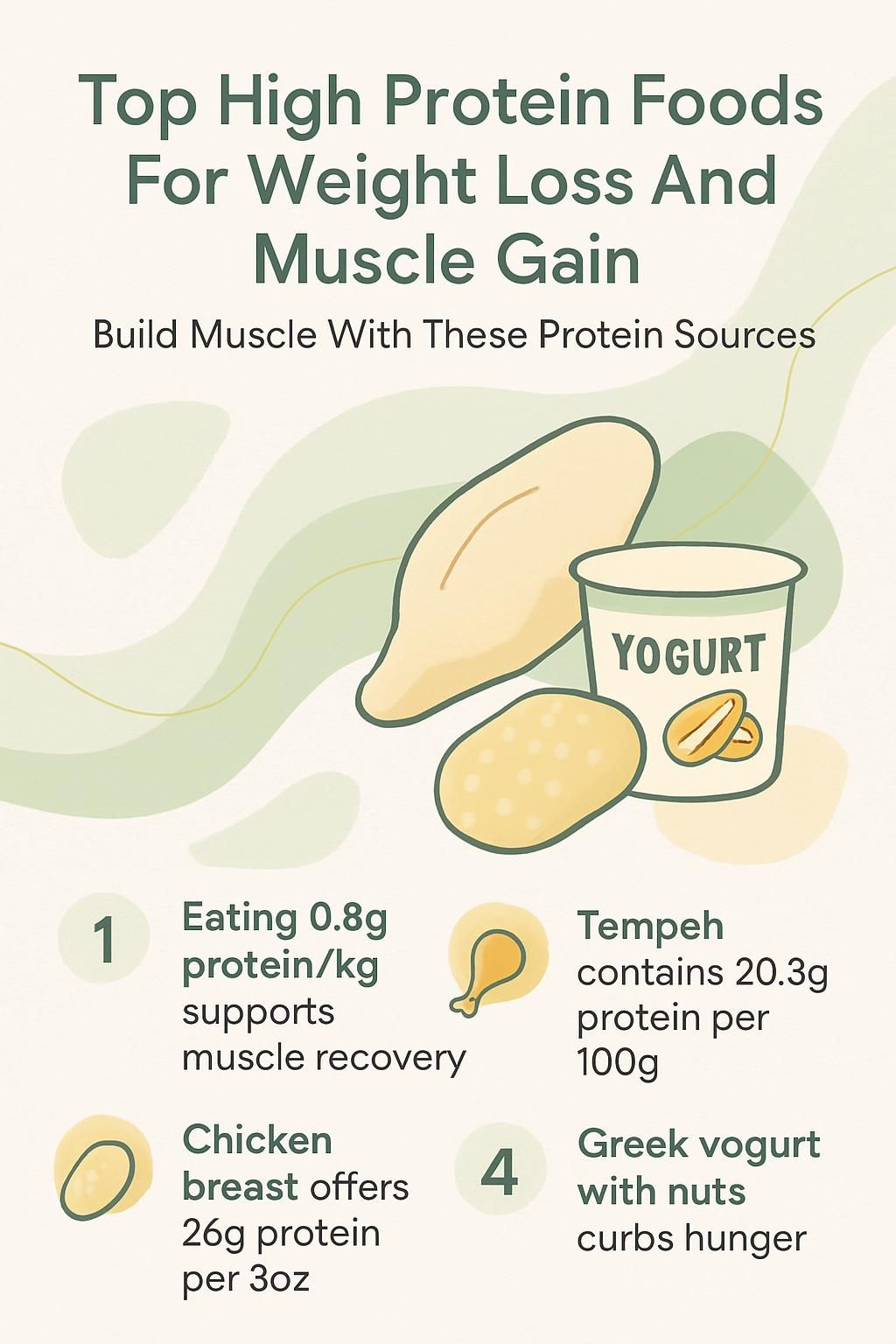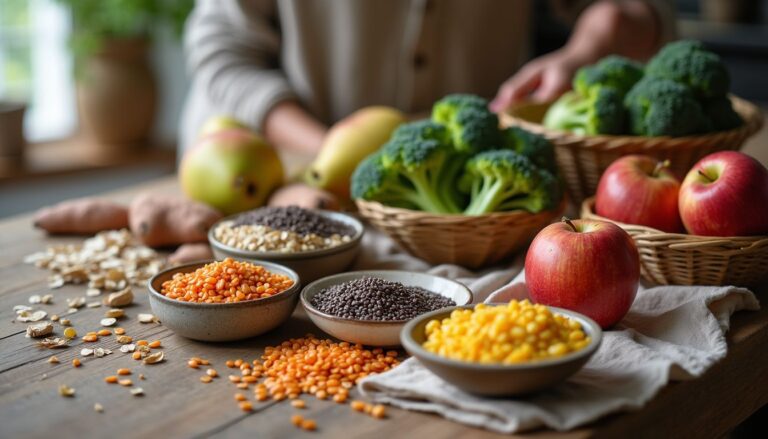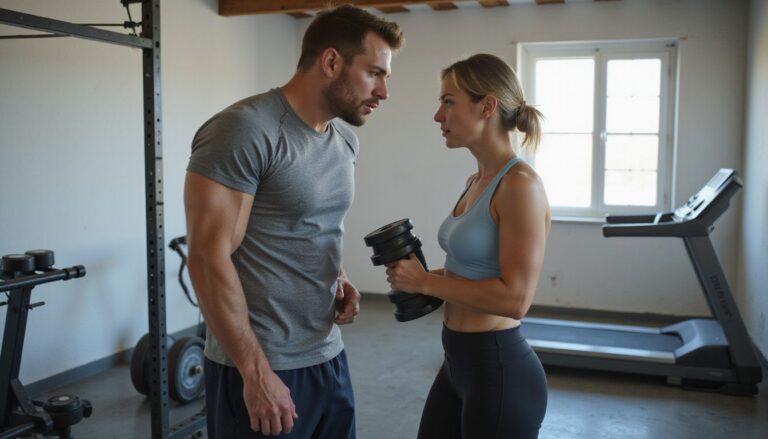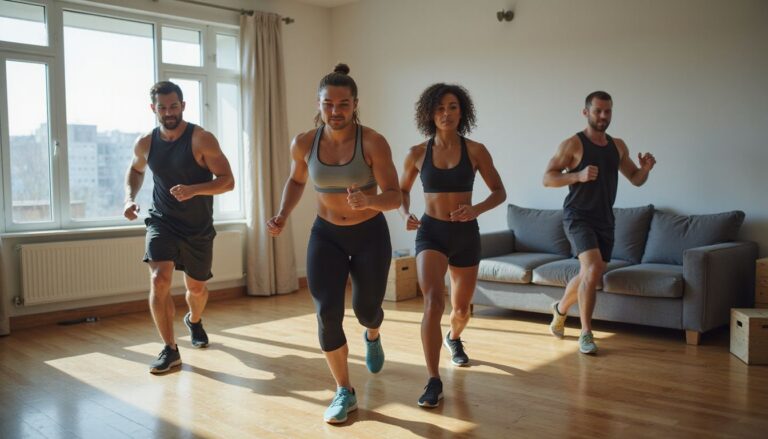Top High Protein Foods For Weight Loss And Muscle Gain: Build Muscle With These Protein Sources
Our Nutrition Assistant AI Suite will transform your body. You will lose fat, get toned, and build muscle. Gain confidence and optimal health.
If you struggle to build muscle or lose weight, protein may be the missing piece. High-protein foods help you protect lean muscle, stay full longer, and manage calories with less stress. A steady high-protein diet also supports recovery after workouts and keeps you on track with goals.
This guide highlights top protein sources from animals and plants, quick high-protein snacks, and simple ways to add protein to every meal. Use these ideas to strengthen your nutrition and reach your targets with confidence.
Key Takeaways
- Aim for at least 0.8 grams of protein per kilogram of body weight daily for basic health. Active people often do better with 1.2 to 2.0 g/kg to support recovery, fat loss, and body composition.
- Top animal protein sources include chicken breast, turkey breast, lean beef, salmon, tuna, and eggs. These provide complete amino acids that support muscle gain and repair.
- Strong plant options include tempeh, firm tofu, lentils, chickpeas, quinoa, edamame, almonds, and chia seeds. Mix several to cover amino acids and fiber needs.
- Smart high-protein snacks include Greek yogurt with nuts, cottage cheese with fruit, hard-boiled eggs, chia seed pudding, and peanut butter with apple.
- Protein has a high thermic effect, about 20 to 30 percent of its calories, which slightly raises daily calorie burn and helps preserve lean mass while dieting.

Why Protein is Essential for Weight Loss and Muscle Gain

Think of protein as building blocks for your body. It helps repair muscle, keeps you satisfied, and supports a healthy metabolism during weight loss.
How does protein help repair and grow muscles?
Your muscles use amino acids, the small units in protein, to repair tiny tears after training. Resistance exercise creates stress in the fibers. Eating protein gives your body the materials to rebuild stronger tissue.
Higher protein intake helps maintain muscle as you reduce calories, which improves body composition over time. A practical baseline is 0.8 grams per kilogram per day for healthy adults. Athletes and lifters often need 1.2 to 2.0 g/kg during hard training.
Muscle repair depends on the amount of protein you eat every day.
After tough lifting sessions, I recover best when I eat 20 to 30 grams of high-quality protein within an hour. That habit cut soreness and sped up strength gains.
How does protein increase fullness and support weight loss?
Protein increases satiety, the feeling of fullness, more than carbs or fat. That means fewer cravings and easier calorie control. Studies show higher-protein meals reduce daily intake, which supports steady weight loss.
Plan 25 to 35 grams of protein at meals, especially at breakfast. Options like eggs, Greek yogurt, chicken breast, or beans help limit snacking and prevent rebound hunger later.
What effect does protein have on metabolism?
Protein has a higher thermic effect of food, which is the energy used to digest and process nutrients. Your body uses about 20 to 30 percent of protein calories during digestion, compared with 5 to 10 percent for carbs and 0 to 3 percent for fat.
That extra cost can add roughly 80 to 100 calories to daily burn. Keeping muscle while losing fat also helps maintain your resting metabolism, which supports long-term weight control.
Top Animal-Based Protein Sources
Animal protein sources are dense in essential amino acids. They are convenient choices when you want maximum protein per calorie.
What are the best animal proteins like chicken breast?
Skinless chicken breast offers one of the best protein-to-calorie ratios. It delivers about 22.5 grams per 100 grams, or roughly 26 grams per 3 ounces. Saturated fat is low, which makes it a lean source of protein for muscle gain and weight loss.
Turkey breast is similar. Lean beef labeled loin or round also works well. Choose minimally processed options to limit sodium and protect heart health.
Why choose turkey breast for protein?
Cooked, skinless turkey breast provides about 30.1 grams of protein per 100 grams. It is low in fat, high in protein, and very versatile for meal prep. This makes it ideal for building muscle while controlling calories.
How does lean beef support muscle gain?
Lean beef, including extra-lean ground beef, supplies about 25.1 grams of protein per 100 grams. It supports muscle protein synthesis after strength training and offers iron, zinc, and vitamin B12, nutrients that support energy and recovery.
Bison, another lean red meat, provides a similar protein amount. Trim visible fat and choose grilling, broiling, or stir-frying to keep calories balanced.
Which fish types are high in protein?
Salmon offers about 22.1 grams of protein per 100 grams and supplies omega-3 fats that support heart health. Tuna, especially canned and drained, has about 23.6 grams per 100 grams. Halibut provides about 18.4 grams per 100 grams.
A typical 3-ounce fillet gives 17 to 20 grams of quality protein. Fish fits well into quick lunches and dinners, which helps you hit protein goals consistently.
Are eggs a good source of protein?
Yes. One large egg has about 6 grams of high-quality protein and all essential amino acids. Eggs are nutrient dense, providing B12, iron, and choline, which support energy production and brain health.
Scramble, poach, or boil them for meals and snacks. Pair with vegetables or whole-grain toast for a balanced plate.
What low-fat dairy options are high in protein?
Plain low-fat Greek yogurt gives about 9.95 grams per 100 grams. Cottage cheese offers around 11.1 grams per 100 grams, or roughly 12.4 grams per half cup. Low-fat milk has about 8 grams per cup.
These choices provide calcium for bone health and steady protein to support muscle. Use them in bowls, smoothies, or savory dips.
On busy weeks, I batch-cook chicken and boil eggs for ready protein. That one habit helps me stay consistent without last-minute stress.
Best Plant-Based Protein Sources
Plant-based protein supports muscle growth and weight control while adding fiber and micronutrients. Mix several sources to cover your needs.
How do tofu and tempeh provide protein?
Tofu and tempeh are soy-based foods with complete protein. Firm tofu provides about 10 grams per 100 grams. Tempeh offers about 20.3 grams per 100 grams, more than double tofu.
Both are cholesterol-free and easy to season. Try them baked, stir-fried, or crumbled into sauces for extra protein and texture.
What lentils and beans offer the most protein?
Chickpeas provide about 21.3 grams of protein per 100 grams dry. Cooked lentils give about 9 grams per half cup. Black beans deliver about 8.86 grams per 100 grams, and kidney beans offer around 7.7 grams per half cup cooked.
These legumes add fiber and minerals that support fullness and stable energy. Use them in soups, salads, stews, and grain bowls.
Why include edamame in a high-protein diet?
Edamame gives about 8 grams of protein per half cup and supplies fiber, iron, and magnesium. It works as a snack, side dish, or salad topper, and it is quick to steam or microwave.
Which nuts are best for protein intake?
Almonds provide about 21.2 grams per 100 grams, about 6 grams per ounce. Pistachios offer about 20.2 grams per 100 grams. Peanuts are legumes but count as nuts in many diets, and 2 tablespoons of natural peanut butter deliver about 7 grams of protein.
Nuts also supply healthy fats and minerals that support heart health. Watch portions since calories add up quickly.
How do seeds like chia and flax contribute protein?
Chia seeds provide about 16.5 grams of protein per 100 grams. Flax seeds are similar. Both deliver omega-3 fats and fiber, which support heart health and digestion.
Sprinkle seeds into smoothies, oatmeal, or yogurt. Two tablespoons in overnight oats can bump protein with little effort.
Is quinoa a complete plant protein source?
Yes. Quinoa is a gluten-free grain that supplies all nine essential amino acids. Cooked quinoa provides about 4.4 grams of protein per 100 grams and pairs well with beans, tofu, or eggs.
To simplify my lunches, I cook a big batch of quinoa and lentils on Sundays. That base makes quick, balanced meals all week.
High-Protein Snacks to Support Your Goals
Snacks rich in protein can steady energy between meals and make your daily target easier to reach.
How to make Greek yogurt with nuts a protein snack?
Start with plain low-fat Greek yogurt. It provides close to 10 grams of protein per 100 grams. Add a handful of almonds, walnuts, or pecans for crunch and healthy fats. One ounce of almonds adds about 6 grams of protein.
Choose unsweetened yogurt to control added sugar. Top with berries for fiber, vitamins, and flavor.
Why are hard-boiled eggs a good high-protein snack?
Hard-boiled eggs are portable and budget-friendly. Each large egg offers about 6 grams of protein and a complete amino acid profile. Keep a batch in the fridge for quick snacks all week.
How does cottage cheese with fruit support protein needs?
A half cup of low-fat cottage cheese delivers around 12.4 grams of protein. It is filling and supports muscle repair after training. For general health, a simple formula is weight in pounds times 0.36 to estimate a minimum protein need per day.
Pair with berries or pineapple for fiber and micronutrients. This mix supports fullness and reduces the urge to overeat.
What is chia seed pudding and why is it high in protein?
Chia pudding forms when chia seeds soak in milk or a plant-based alternative. It turns creamy and spoonable. Chia seeds supply protein, fiber, omega-3 fats, and calcium. Stir in Greek yogurt to boost protein further without many extra calories.
How does peanut butter with apple slices help protein intake?
Two tablespoons of natural peanut butter provide about 7 grams of protein. Apple slices add fiber and crunch. This combo curbs hunger and delivers a sweet-salty bite that keeps you on track.
I keep single-serve nut butter packets in my gym bag. They make post-workout snacking simple and consistent.
Benefits of Including High-Protein Foods in Your Diet
High-protein eating supports recovery, performance, and appetite control. It also helps preserve lean tissue while you drop body fat.
How does protein promote muscle recovery and growth?
Exercise creates tiny muscle tears. Protein supplies amino acids to repair them and build stronger fibers. Post-workout protein, such as 20 to 40 grams of whey or a lean meal, improves rebuilding and limits muscle loss during dieting.
I noticed less soreness once I raised my protein and timed it after lifting. Progress felt steadier from week to week.
Can protein increase fat loss while preserving muscle?
Yes. Higher protein during a calorie deficit helps keep lean mass while promoting fat loss. Research in the American Journal of Clinical Nutrition shows that increased protein can raise thermogenesis, the heat your body produces when processing food, which supports fat loss while protecting muscle.
Many lifters do well with 0.6 to 1.0 grams per pound of body weight during cutting phases, depending on training volume and body fat.
How does protein boost energy and performance?
Protein supports tissue repair and stable blood sugar when paired with carbs and healthy fats. Balanced meals help you train harder and recover faster. Options like Greek yogurt with fruit or chicken with rice can reduce mid-workout fatigue.
Why does protein reduce hunger and prevent overeating?
Protein lowers the hunger hormone ghrelin and increases satiety signals. Spreading protein across meals controls cravings and reduces late-night snacking. Eating enough protein makes sticking to a calorie target much easier.
Tips for Incorporating Protein into Every Meal
Small changes add up. A few smart swaps can raise your protein intake without complicated cooking.
How can you start your day with a protein-rich breakfast?
Build breakfast around eggs, Greek yogurt, or cottage cheese. Two eggs plus a cup of Greek yogurt can top 20 grams of protein. Add chia or flax for fiber and healthy fats. Include whole-grain toast or fruit for steady energy.
What are easy ways to add lean protein to salads and sandwiches?
Use grilled chicken breast, turkey breast, or hard-boiled eggs. For a plant option, add half a cup of lentils or beans for about 9 grams of protein. Tofu cubes or tempeh slices also work well. Greek yogurt can replace mayo to raise protein in dressings and spreads.
How to use protein powder effectively in smoothies?
One scoop of whey protein typically provides 20 to 25 grams. Blend with low-fat milk or soy milk for extra protein and a creamy texture. Add fruit for vitamins and oats or nut butter for staying power. Drink after workouts to support repair and recovery.
Why pair protein with healthy carbs and fats?
Carbs refuel muscles, and fats help absorb vitamins A, D, E, and K. Combining all three keeps blood sugar steady and supports heart health. A balanced plate might include salmon, quinoa, and avocado with a side of vegetables.
How to plan high-protein meal prep for the week?
Choose 2 or 3 proteins, such as chicken breast, fish, and tofu. Add Greek yogurt or cottage cheese for snacks. Prep legumes like lentils or chickpeas and a grain like quinoa or brown rice. Roast a tray of mixed vegetables.
Portion meals into containers so choices are easy. For general needs, multiply body weight in pounds by 0.36 to estimate a daily minimum. For muscle building, many aim for 0.7 to 1.0 grams per pound. Tracking a few days can reveal gaps and guide adjustments.
Weekend prep makes weekdays smoother. It also keeps your protein intake consistent, which supports both fat loss and muscle gain.
Common Myths About High-Protein Diets
Misinformation about protein is common. Knowing the facts helps you build a plan that fits your health and goals.
Does eating high protein damage your kidneys?
For people with healthy kidneys, higher protein intakes do not cause kidney damage. The kidneys filter byproducts of protein metabolism, and they adapt within normal ranges. If you have kidney disease, talk with your clinician before raising protein.
Is plant protein less effective than animal protein?
Plant protein can build muscle as well as animal protein when total intake is adequate. Complete options like soy and quinoa help, and mixing beans, grains, and seeds covers amino acids. Consistency across the day matters more than any single source.
Can eating too much protein turn into fat?
Your body cannot store extra protein as protein. Surplus calories from any source, including protein, can be stored as fat. Hit your protein target, then manage total calories based on your goal. If using protein supplements, count them in your daily totals.
How Much Protein Do You Need?
Protein needs depend on age, activity, and goals. The RDA is 0.8 grams per kilogram of body weight for healthy adults, which supports basic health. Active people and lifters often need more to fuel training and recovery.
What are general daily protein intake guidelines?
Meeting your daily protein intake is essential for muscle gain and weight loss. The 2020-2025 Dietary Guidelines for Americans recommend a baseline of 0.8 grams of protein per kilogram of body weight for healthy adults. Your protein needs can vary based on activity level, health status, and fitness goals. Use this table as a quick guide to daily protein recommendations.
| Population Group | Recommended Protein Intake (g/kg body weight/day) | Example* | Comments |
|---|---|---|---|
| Healthy Adults (General) | 0.8 | 56g for 70kg person | Minimum for basic health and maintenance |
| Active Adults / Recreational Athletes | 1.0 – 1.2 | 70 – 84g for 70kg person | Supports increased activity and minor muscle repair |
| Endurance Athletes | 1.2 – 1.4 | 84 – 98g for 70kg person | Supports muscle recovery and performance |
| Strength Training / Muscle Gain | 1.4 – 2.0 | 98 – 140g for 70kg person | Promotes muscle growth and repair |
| Older Adults (65+) | 1.0 – 1.2 | 70 – 84g for 70kg person | Helps prevent muscle loss with age |
| Weight Loss (Calorie Deficit) | 1.2 – 1.6 | 84 – 112g for 70kg person | Preserves lean mass during fat loss |
*Example based on a 70kg (154lb) person.
Protein sources like chicken breast, Greek yogurt, eggs, tofu, and lentils can help you meet these targets.
How much protein is needed for weight loss?
For fat loss while preserving muscle, many people do well with 0.6 to 0.8 grams per pound of body weight each day. A 150-pound person would aim for about 90 to 120 grams daily. Pair this intake with resistance training for best results.
Pick lean, nutrient-dense options such as chicken breast, fish, eggs, nonfat Greek yogurt, and tofu. These supply essential amino acids without excess saturated fat or calories.
What protein intake supports muscle gain and bodybuilding?
Target 1.6 to 2.2 grams per kilogram of body weight per day to support muscle gain. That equals about 112 to 154 grams daily for a 70-kilogram person. Split protein across 3 or 4 meals to support muscle protein synthesis.
During hard training blocks, I anchor meals around 30 to 40 grams of protein. Recovery and strength improve when I stay consistent.
Conclusion
High-protein foods make it easier to build muscle and manage weight. Chicken breast, salmon, eggs, Greek yogurt, tofu, beans, and quinoa all offer reliable protein for repair, fullness, and steady energy. Mix animal and plant protein sources for variety and a complete nutrient profile.
Pair protein with fruits, vegetables, whole grains, and healthy fats to round out meals. Add one or two high-protein snacks each day to stay on plan. If you have kidney disease or other medical concerns, speak with a healthcare professional before changing your intake.
With simple planning, you can meet daily protein needs, protect lean mass, and move closer to your goals on a high-protein diet.
FAQs
1. What are the best high protein foods for weight loss and muscle gain?
Lean meats like chicken breast, turkey, and fish provide quality protein. Eggs, Greek yogurt, cottage cheese, tofu, lentils, and beans also offer strong protein content. These foods help build muscle while supporting weight loss goals.
2. How does eating more protein support muscle growth?
Protein was associated with increased muscle mass in several studies. Consuming enough dietary protein gives your body the amino acids needed to repair and grow muscles after exercise.
3. Are minerals important when choosing high-protein foods?
Yes; many high-protein sources contain essential minerals such as iron, zinc, magnesium, or calcium. These nutrients support metabolism and overall health during weight loss or strength training efforts.
4. Can plant-based proteins be effective for building muscle?
Plant-based options like lentils and beans supply both mineral (nutrient) content and adequate protein levels for most people’s needs. Combining different plant proteins can ensure a complete amino acid profile that supports healthy muscle gain.
Summary: Choosing lean animal proteins or varied plant-based sources helps meet daily requirements for both protein and key minerals (nutrients). This approach aids in weight management while promoting effective muscle development according to evidence from nutrition research.







